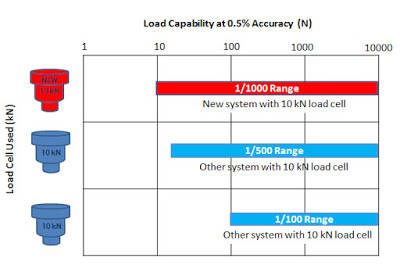First of all, there are two important pieces of information here:
- Load accuracy: ± 0.5% of the reading
- Lowest possible load within this accuracy: 1/100, 1/500, 1/1000 of load cell capacity
For example, let’s assume your test system has a load measurement accuracy of ± 0.5% of reading down to 1/100th of the load cell’s capacity. When a load cell of 10 000 N (10 kN) capacity is used on this test system and a measurement of 1000 N is read, the actual load measurement can be any value from 995 N to 1005 N. For this 10 kN capacity load cell, the minimum possible load that is guaranteed to meet the load accuracy of ± 0.5% of reading is 100 N.
Now, imagine you have a newer system with a new 10 kN load cell and the load measurement accuracy of ± 0.5% of reading is now extended down to 1/1000th of the load cell’s capacity. The load measurement accuracy of ± 0.5% of reading remains, but now the minimum possible load that is guaranteed to meet the load accuracy of ± 0.5% of reading is extended down to 10 N.
So what does a larger load accuracy range mean to you? Here are some of the benefits you will see:
- Less initial cost since less load cells are needed
- Lower subsequent service costs as fewer load cells need to be verified annually
- Less operator error and improved throughput (number of specimens tested per hour) by not having to change load cells between different test types such as tensile and flexure tests.
- Higher confidence in test data for low load tests.
